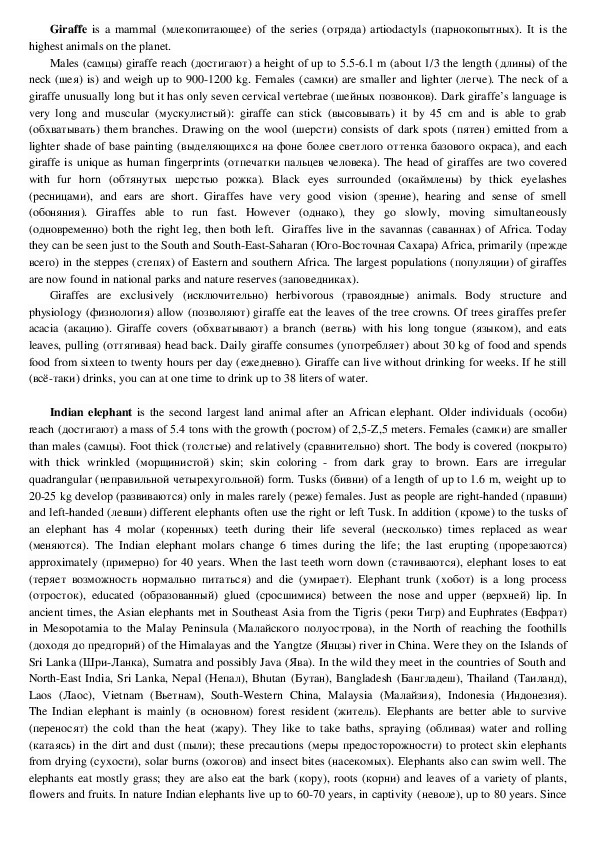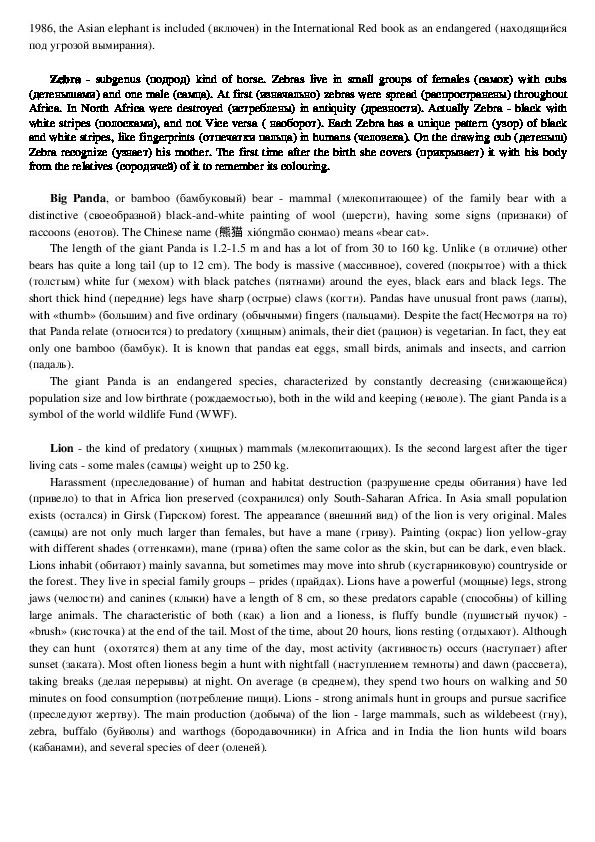Giraffe is a mammal (млекопитающее) of the series (отряда) artiodactyls (парнокопытных). It is the
highest animals on the planet.
Males (самцы) giraffe reach (достигают) a height of up to 5.56.1 m (about 1/3 the length (длины) of the
neck (шея) is) and weigh up to 9001200 kg. Females (самки) are smaller and lighter (легче). The neck of a
giraffe unusually long but it has only seven cervical vertebrae (шейных позвонков). Dark giraffe’s language is
very long and muscular (мускулистый): giraffe can stick (высовывать) it by 45 cm and is able to grab
(обхватывать) them branches. Drawing on the wool (шерсти) consists of dark spots (пятен) emitted from a
lighter shade of base painting (выделяющихся на фоне более светлого оттенка базового окраса), and each
giraffe is unique as human fingerprints (отпечатки пальцев человека). The head of giraffes are two covered
with fur horn (обтянутых шерстью рожка). Black eyes surrounded (окаймлены) by thick eyelashes
(ресницами), and ears are short. Giraffes have very good vision (зрение), hearing and sense of smell
(обоняния). Giraffes able to run fast. However (однако), they go slowly, moving simultaneously
(одновременно) both the right leg, then both left. Giraffes live in the savannas (саваннах) of Africa. Today
they can be seen just to the South and SouthEastSaharan (ЮгоВосточная Сахара) Africa, primarily (прежде
всего) in the steppes (степях) of Eastern and southern Africa. The largest populations (популяции) of giraffes
are now found in national parks and nature reserves (заповедниках).
Giraffes are exclusively (исключительно) herbivorous (травоядные) animals. Body structure and
physiology (физиология) allow (позволяют) giraffe eat the leaves of the tree crowns. Of trees giraffes prefer
acacia (акацию). Giraffe covers (обхватывают) a branch (ветвь) with his long tongue (языком), and eats
leaves, pulling (оттягивая) head back. Daily giraffe consumes (употребляет) about 30 kg of food and spends
food from sixteen to twenty hours per day (ежедневно). Giraffe can live without drinking for weeks. If he still
(всётаки) drinks, you can at one time to drink up to 38 liters of water.
Indian elephant is the second largest land animal after an African elephant. Older individuals (особи)
reach (достигают) a mass of 5.4 tons with the growth (ростом) of 2,5Z,5 meters. Females (самки) are smaller
than males (самцы). Foot thick (толстые) and relatively (сравнительно) short. The body is covered (покрыто)
with thick wrinkled (морщинистой) skin; skin coloring from dark gray to brown. Ears are irregular
quadrangular (неправильной четырехугольной) form. Tusks (бивни) of a length of up to 1.6 m, weight up to
2025 kg develop (развиваются) only in males rarely (реже) females. Just as people are righthanded (правши)
and lefthanded (левши) different elephants often use the right or left Tusk. In addition (кроме) to the tusks of
an elephant has 4 molar (коренных) teeth during their life several (несколько) times replaced as wear
(меняются). The Indian elephant molars change 6 times during the life; the last erupting (прорезаются)
approximately (примерно) for 40 years. When the last teeth worn down (стачиваются), elephant loses to eat
(теряет возможность нормально питаться) and die (умирает). Elephant trunk (хобот) is a long process
(отросток), educated (образованный) glued (сросшимися) between the nose and upper (верхней) lip. In
ancient times, the Asian elephants met in Southeast Asia from the Tigris (реки Тигр) and Euphrates (Евфрат)
in Mesopotamia to the Malay Peninsula (Малайского полуострова), in the North of reaching the foothills
(доходя до предгорий) of the Himalayas and the Yangtze (Янцзы) river in China. Were they on the Islands of
Sri Lanka (ШриЛанка), Sumatra and possibly Java (Ява). In the wild they meet in the countries of South and
NorthEast India, Sri Lanka, Nepal (Непал), Bhutan (Бутан), Bangladesh (Бангладеш), Thailand (Таиланд),
Laos (Лаос), Vietnam (Вьетнам), SouthWestern China, Malaysia (Малайзия), Indonesia (Индонезия).
The Indian elephant is mainly (в основном) forest resident (житель). Elephants are better able to survive
(переносят) the cold than the heat (жару). They like to take baths, spraying (обливая) water and rolling
(катаясь) in the dirt and dust (пыли); these precautions (меры предосторожности) to protect skin elephants
from drying (сухости), solar burns (ожогов) and insect bites (насекомых). Elephants also can swim well. The
elephants eat mostly grass; they are also eat the bark (кору), roots (корни) and leaves of a variety of plants,
flowers and fruits. In nature Indian elephants live up to 6070 years, in captivity (неволе), up to 80 years. Since1986, the Asian elephant is included (включен) in the International Red book as an endangered (находящийся
под угрозой вымирания).
Zebra subgenus (подрод) kind of horse. Zebras live in small groups of females (самок) with cubs
(детенышами) and one male (самца). At first (изначально) zebras were spread (распространены) throughout
Africa. In North Africa were destroyed (истреблены) in antiquity (древности). Actually Zebra black with
white stripes (полосками), and not Vice versa ( наоборот). Each Zebra has a unique pattern (узор) of black
and white stripes, like fingerprints (отпечатки пальца) in humans (человека). On the drawing cub (детеныш)
Zebra recognize (узнает) his mother. The first time after the birth she covers (прикрывает) it with his body
from the relatives (сородичей) of it to remember its colouring.
Big Panda, or bamboo (бамбуковый) bear mammal (млекопитающее) of the family bear with a
distinctive (своеобразной) blackandwhite painting of wool (шерсти), having some signs (признаки) of
raccoons (енотов). The Chinese name (熊猫 xióngmāo сюнмао) means «bear cat».
The length of the giant Panda is 1.21.5 m and has a lot of from 30 to 160 kg. Unlike (в отличие) other
bears has quite a long tail (up to 12 cm). The body is massive (массивное), covered (покрытое) with a thick
(толстым) white fur (мехом) with black patches (пятнами) around the eyes, black ears and black legs. The
short thick hind (передние) legs have sharp (острые) claws (когти). Pandas have unusual front paws (лапы),
with «thumb» (большим) and five ordinary (обычными) fingers (пальцами). Despite the fact(Несмотря на то)
that Panda relate (относится) to predatory (хищным) animals, their diet (рацион) is vegetarian. In fact, they eat
only one bamboo (бамбук). It is known that pandas eat eggs, small birds, animals and insects, and carrion
(падаль).
The giant Panda is an endangered species, characterized by constantly decreasing (снижающейся)
population size and low birthrate (рождаемостью), both in the wild and keeping (неволе). The giant Panda is a
symbol of the world wildlife Fund (WWF).
Lion the kind of predatory (хищных) mammals (млекопитающих). Is the second largest after the tiger
living cats some males (самцы) weight up to 250 kg.
Harassment (преследование) of human and habitat destruction (разрушение среды обитания) have led
(привело) to that in Africa lion preserved (сохранился) only SouthSaharan Africa. In Asia small population
exists (остался) in Girsk (Гирском) forest. The appearance (внешний вид) of the lion is very original. Males
(самцы) are not only much larger than females, but have a mane (гриву). Painting (окрас) lion yellowgray
with different shades (оттенками), mane (грива) often the same color as the skin, but can be dark, even black.
Lions inhabit (обитают) mainly savanna, but sometimes may move into shrub (кустарниковую) countryside or
the forest. They live in special family groups – prides (прайдах). Lions have a powerful (мощные) legs, strong
jaws (челюсти) and canines (клыки) have a length of 8 cm, so these predators capable (способны) of killing
large animals. The characteristic of both (как) a lion and a lioness, is fluffy bundle (пушистый пучок)
«brush» (кисточка) at the end of the tail. Most of the time, about 20 hours, lions resting (отдыхают). Although
they can hunt (охотятся) them at any time of the day, most activity (активность) occurs (наступает) after
sunset (заката). Most often lioness begin a hunt with nightfall (наступлением темноты) and dawn (рассвета),
taking breaks (делая перерывы) at night. On average (в среднем), they spend two hours on walking and 50
minutes on food consumption (потребление пищи). Lions strong animals hunt in groups and pursue sacrifice
(преследуют жертву). The main production (добыча) of the lion large mammals, such as wildebeest (гну),
zebra, buffalo (буйволы) and warthogs (бородавочники) in Africa and in India the lion hunts wild boars
(кабанами), and several species of deer (оленей).


